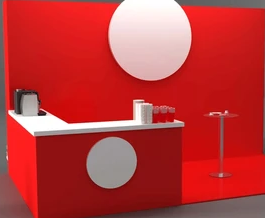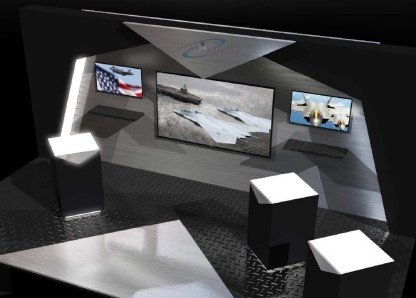Trade shows provide an excellent opportunity for businesses to showcase their products, network with potential clients, and gain visibility in their industry. However, in an event that features dozens, if not hundreds, of competing booths, it can be challenging to stand out and leave a lasting impression. Creating an immersive environment in your trade show booth is a powerful strategy to captivate your audience, engage them meaningfully, and elevate your brand’s presence. In this article, we’ll explore the essential elements for creating an immersive experience, from booth design to interactive technology and beyond.
Why Immersive Environments Matter
In today’s fast-paced world, attention spans are shorter than ever, and traditional marketing tactics are becoming less effective. People attending trade shows are typically inundated with information and presentations. To make an impact, your booth needs to go beyond the conventional, offering an experience that draws visitors in, encourages them to interact, and makes them feel connected to your brand on a deeper level.
An immersive environment is one that appeals to multiple senses—sight, sound, touch, and sometimes even smell. The goal is to transport visitors into an experience that feels real and relevant, so they become more engaged with your brand. When done correctly, this type of environment can lead to higher engagement, longer booth visits, stronger brand recall, and ultimately, more conversions.
1. Craft a Compelling Story
At the heart of every immersive experience lies a compelling story. Whether it’s the journey of how your company was founded, the innovative process behind your products, or a problem your brand aims to solve, storytelling plays a crucial role in establishing an emotional connection with your audience. A strong narrative makes the experience more memorable and relatable.
Start by defining your brand’s key message and how you want visitors to perceive your company. From there, weave that message into every element of your booth. Consider incorporating a storyline that visitors can follow as they explore different parts of your booth. For example, you could set up interactive displays that take visitors through your brand’s evolution or highlight different aspects of your product’s journey—from development to real-world application.
Storytelling can also be enhanced through the use of visuals, text, and video content that reinforce your narrative. Incorporate videos that highlight customer testimonials, behind-the-scenes footage, or success stories that bring your brand to life.
2. Design a Visually Stunning Booth
The design of your booth is the first thing that will capture attendees’ attention, so it needs to be striking, yet functional. A visually appealing booth can spark curiosity and encourage people to step inside. However, aesthetics alone aren’t enough; your booth needs to convey your brand identity and message seamlessly.
Color Scheme and Branding: Choose colors that are consistent with your brand’s identity. For example, if your brand uses specific colors in its logo or marketing materials, incorporate these colors into your booth design to reinforce brand recognition. Bright, bold colors can attract attention, but ensure that they don’t overwhelm the senses.
Lighting: Lighting plays a key role in setting the mood and atmosphere in your booth. Use lighting strategically to highlight key products or areas, create drama, and draw attention to certain features. LED lights, spotlights, and backlighting can create a dynamic environment that shifts throughout the day. Additionally, consider using interactive lighting, where the lights change based on a visitor’s actions.
Layout and Flow: The layout of your booth should be easy to navigate while also encouraging people to explore. A well-organized space allows visitors to flow naturally from one section to the next, experiencing different aspects of your brand. Avoid cluttering the space with too many displays. Instead, focus on a few key elements that create impact and build interest.
Custom Structures and Signage: To stand out, consider using custom-built structures or walls that showcase your brand. Incorporating a large, eye-catching sign or even 3D elements like sculptures or logos can make your booth instantly recognizable from a distance.
3. Incorporate Interactive Technology
Technology is a vital tool when it comes to creating an immersive trade show experience. With the rise of digital tools, it’s easier than ever to engage visitors in innovative ways. By incorporating interactive technology into your booth, you provide an engaging, hands-on experience that can increase visitor involvement and improve brand retention.
Augmented Reality (AR) and Virtual Reality (VR): One of the most effective ways to create an immersive experience is through AR and VR technology. AR allows visitors to interact with digital elements overlaid onto the physical world, while VR can transport them to entirely different environments. For example, if your company sells real estate, you could offer VR tours of properties, or if you’re in the automotive industry, you could offer a VR test drive.
Interactive Touchscreens and Kiosks: Touchscreens are a fantastic way to engage visitors by allowing them to interact with product information, videos, and even configure products to their liking. Touchscreens are versatile tools that can be used to showcase product demos, display testimonials, or even offer personalized content based on user preferences.
Gamification: Adding a fun, competitive element to your booth is a great way to boost engagement. Interactive games and challenges, such as quizzes, trivia, or a virtual scavenger hunt, can encourage visitors to spend more time in your booth. Rewards, prizes, or even just a leaderboard can create excitement and motivate people to participate.
Projection Mapping: This technology allows you to project images or videos onto surfaces in your booth, transforming ordinary objects into dynamic, moving visuals. Projection mapping can be used to animate your logo, showcase product features, or tell your brand story in a captivating way.
4. Engage the Senses
To create an immersive environment, it’s important to engage all five senses. While sight and sound are the most common sensory elements used in trade shows, incorporating touch, taste, and smell can elevate the experience and create a more memorable visit.
Sight: As mentioned earlier, visuals are key to an immersive environment. Use bold colors, video projections, and dynamic lighting to captivate attention and create atmosphere. Make sure your booth tells a story through these visual elements to help visitors connect with your brand.
Sound: Sound plays an important role in shaping the mood and energy of your booth. Carefully select background music that matches the tone of your brand and complements your product offerings. However, be cautious about making the music too loud, as it could overwhelm visitors and make conversation difficult. If your product can benefit from sound effects, incorporate them subtly, such as with demonstrations or videos that are enhanced by sound.
Touch: Incorporating tactile elements into your booth allows visitors to physically interact with your products. This could involve offering product samples, textures to feel, or interactive touchscreens that engage people in meaningful ways.
Taste and Smell: Though these senses are more challenging to incorporate, they can significantly enhance the experience. If applicable, offer tastings of your product (e.g., food or beverages). Scent can be subtly introduced using diffusers that align with your brand—citrus for energy, lavender for relaxation, or leather for a high-end feel.
5. Offer Live Demonstrations and Presentations
Live demonstrations are an excellent way to engage your audience and provide hands-on experiences with your products or services. These can be scheduled throughout the day to give attendees the opportunity to witness your product in action, ask questions, and even interact with it directly.
Product demos are particularly impactful when combined with storytelling. For example, rather than simply showing how a product works, narrate a real-life scenario that demonstrates its benefits. This helps visitors visualize themselves using your product and strengthens the emotional connection.
Additionally, if your brand offers services, consider offering live consultations, workshops, or presentations that showcase your expertise. This not only attracts visitors to your booth but also positions your brand as an industry leader.
6. Train Your Booth Staff
A well-trained team is vital to maintaining an immersive experience. Your booth staff should be approachable, knowledgeable, and passionate about your brand. Visitors will spend more time in your booth if they feel welcomed and engaged by enthusiastic staff members who can provide valuable information and facilitate interactive experiences.
Make sure your team is trained to operate all technology, explain the immersive elements, and guide visitors through the booth’s offerings. Staff should also be proactive in starting conversations and inviting attendees to engage with the booth’s displays and experiences.
7. Follow Up After the Event
Once the trade show ends, the work isn’t over. Following up with the contacts you made during the event is essential for turning booth interactions into business opportunities. Send personalized messages, offer special promotions, or provide additional content that reinforces the immersive experience visitors had at your booth.
By nurturing these relationships after the event, you can continue the engagement and increase the likelihood of conversion.
Creating an immersive environment in your trade show booth is an effective way to differentiate your brand, engage your audience, and leave a lasting impression. By combining captivating storytelling, innovative technology, sensory elements, and knowledgeable staff, you can transform your booth into an experience that visitors won’t forget. The effort you put into crafting an immersive environment will not only boost your visibility at the event but also create lasting connections that benefit your business long after the trade show ends.




